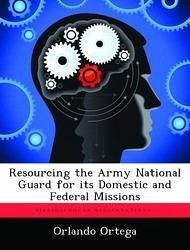Nicht lieferbar

Resourcing the Army National Guard for its Domestic and Federal Missions
Versandkostenfrei!
Nicht lieferbar
The National Guard is an integral part of the military's operational force deployed around the world, and a first responder in case of a catastrophic disaster in the United States. The use of the Army National Guard has been evolving over the last decade, but for many of those years it has lacked modern equipment to conduct its federal and domestic missions. The September 11, 2001 attacks initiated the transformation of the Army National Guard for the 21st century. This paper explores the complexity of defining the National Guard's domestic and federal missions. Furthermore, it provides the ba...
The National Guard is an integral part of the military's operational force deployed around the world, and a first responder in case of a catastrophic disaster in the United States. The use of the Army National Guard has been evolving over the last decade, but for many of those years it has lacked modern equipment to conduct its federal and domestic missions. The September 11, 2001 attacks initiated the transformation of the Army National Guard for the 21st century. This paper explores the complexity of defining the National Guard's domestic and federal missions. Furthermore, it provides the background of equipment shortages found throughout the National Guard. The research reveals how the Army Force Generation model provides predictability for guardsmen about their potential deployment schedule; however, the model does not take into account the Army National Guard's domestic mission. The way forward for the Army National Guard to improve its execution of federal and domestic mission is the integration of dual-use equipment. This addition of dual-use equipment sets would increase the readiness posture of the Army National Guard. Finally, this paper provides recommendations on the future readiness of the Army National Guard to execute its dual missions. The National Guard's dual missions need to be refined clearly to articulate roles and responsibilities because there are several interpretations as what an Operational Force should be and how it should be resourced. In addition, the difficulty for the Army National Guard to delineate between Homeland Defense, Homeland Security, and support to Civil Authorities missions is complicated. Therefore, resourcing the Army National Guard to execute these missions will strengthen our nation's defenses at home and abroad.







